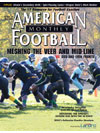AMERICAN FOOTBALL MONTHLY THE #1 RESOURCE FOR FOOTBALL COACHES
Article CategoriesAFM Magazine
|
Developing Deception with the Spread OptionHow Blackburn College uses misdirection to complement their spread schemeby: Mike Kuchar © More from this issue What do spread option and Wing T coaches have in common? A ton of consistency and an utter hell-bent philosophy of running their offensive scheme regardless of any situation or circumstance. For the most part, once you’re induced into the clan of one of these systems, it stays with you forever. Sure some coaches will tweak their systems slightly to fit their personnel, like riding the fullback more if he’s a stud or letting the QB get the majority of carries. But essentially you are what you are and when you’re an option coach, you’re in it for good. It’s like vanilla or chocolate ice cream, Republican or Democrat. You’re one or the other – no flipping allowed. So when offensive coordinator Nate Cochran took over the offensive duties at Division III Blackburn College in Illinois in 2006, he had quite a decision to make. Cochra....The full article can only be seen by subscribers. Subscribe today!
|
|
|||||||
| HOME |
MAGAZINE |
SUBSCRIBE | ONLINE COLUMNISTS | COACHING VIDEOS |
Copyright 2025, AmericanFootballMonthly.com
All Rights Reserved





